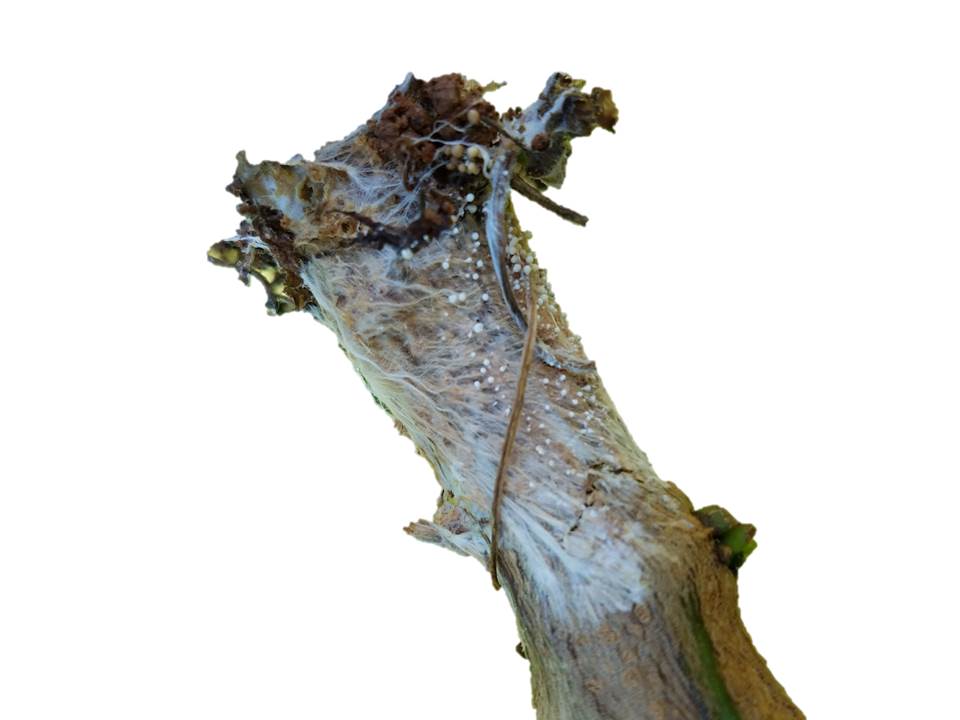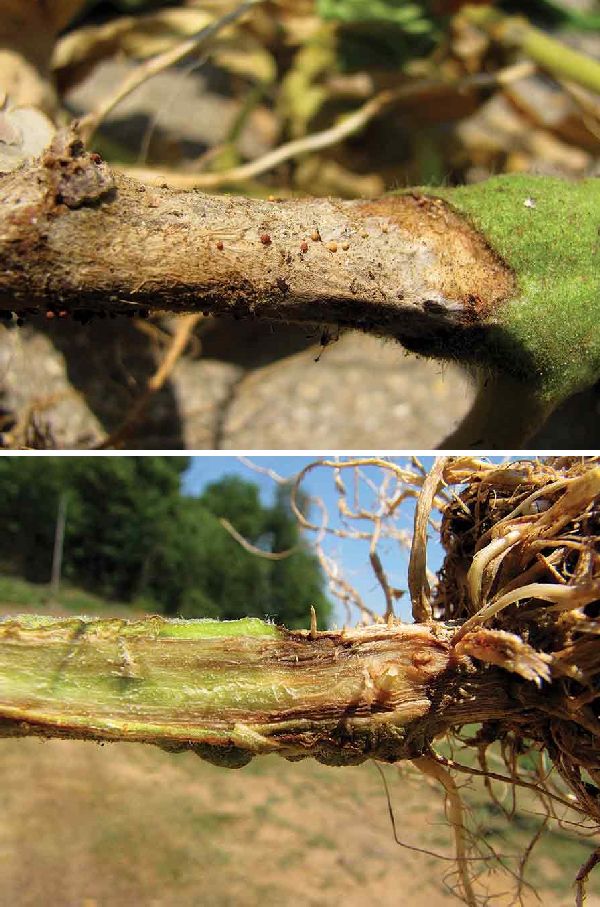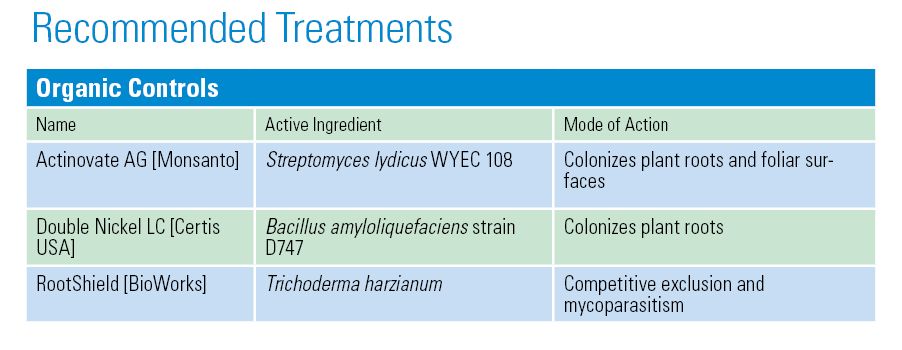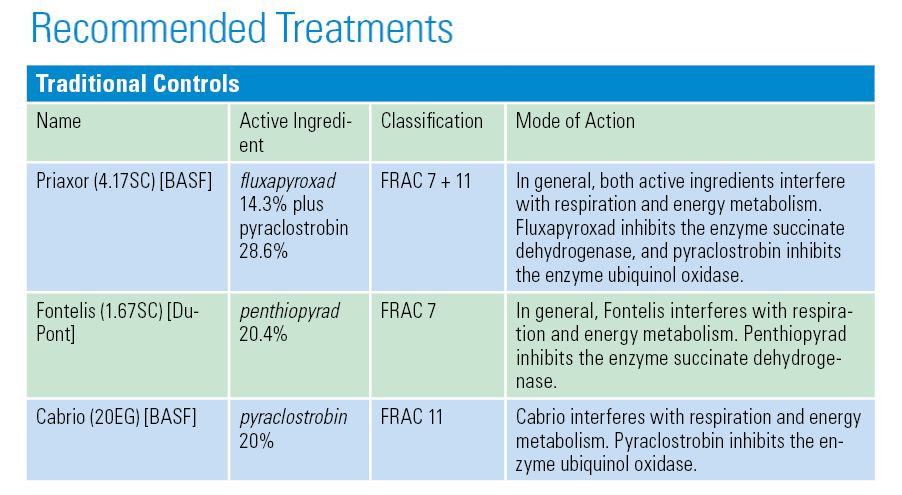Field Scouting Guide: Southern Blight

Southern blight symptoms on a pepper plant. Photo courtesy of Purdue University.
This edition of “Field Scouting Guide” concentrates on Sclerotium rolfsii (aka, southern blight).
We reached out to pathologists to learn how to spot and treat this disease. This installment’s contributors include: Daniel S. Egel, Purdue University; Anthony P. (Tony) Keinath, Ph.D., Clemson University; Steven T. Koike, Director, TriCal Diagnostics Lab; and Joe Nunez, University of California Cooperative Extension.
Southern Blight
- Scientific name: Sclerotium rolfsii
- Common name: Southern Blight
- Crops affected: A particularly big problem on tomatoes and peppers, but also Swiss chard, beans, Jerusalem artichokes (sunchokes), onions, carrots, canary beans, sunflowers, cucumbers, eggplants, cucurbits (cantaloupes, watermelons and pumpkins), potatoes, peanuts, and sweet potatoes.
- Geographical range: Worldwide, especially in warmer tropical and subtropical climates
The Pathogen’s Impact
Nunez: Southern blight is a very destructive, fast acting crown rot disease that rapidly kills the plant. In 2017, southern blight was a big problem. Out of more than 40 crown rot samples received in the University of California Davis Vegetable and Agronomic Crop Pathology program in summer 2017, 50% were southern blight.
This disease was commonly reported to cause more than 50% mortality in affected fields. Most unusually, this disease caused major losses in many northern counties in the San Joaquin and Sacramento valleys, where it is not typically an issue, including Colusa, Yolo, Contra Costa, San Joaquin, and Merced.
The widespread distribution we saw this year is not likely due to pathogen spread to new fields. Since southern blight is favored by high temperatures (more than 86°F), high soil moisture, dense canopies, and frequent irrigation, it seems most plausible that a combination of late planting dates and record high summer temperatures created unusually favorable conditions for the pathogen in the northern part of the valley. Although not a new disease to the state, the increased damage from the disease this year may mean that this will be a bigger issue next year if the environment is conducive and the disease is not properly managed.
Egel: Southern blight is a sporadic problem. It is most often observed in the mid to late season of years that are hot and dry, but a close inspection of the base of the plant may reveal symptoms sooner. In Indiana, southern blight is observed as often in the field as in high tunnel situations where tomatoes are grown in the ground. I have observed southern blight more often in the southern parts of the state. I also have observed this disease on peppers in western North Carolina.
Southern blight is dependent on the presence of the fungus that survives long periods without a host in the soil. Once the fungus is present, southern blight can be a persistent problem. The disease is also dependent on hot, dry weather before severe symptoms become apparent. In the Midwest, the problem is not important on vegetables. To individual growers who have experienced this problem in a field or high tunnel, however, the economic loss can be high.
Keinath: Southern blight is a problem on tomatoes and peppers throughout the southeastern U.S. The lower half of South Carolina along the coastal plain, where the soils are partially sandy, has more southern blight than the upstate areas where soils have clay. Southern blight shows up when the soil warms to 85°F and when tomato and pepper plants are setting fruit; however, I also have seen southern blight on four-week-old tomato transplants.
The economic impact is difficult to measure. In my fungicide trials, I did not see a significant reduction in weight or number of tomato fruit on nonsprayed plants compared to sprayed plants. Large growers have reported losing 10% to 15%of their tomato plants in a year from severe southern blight, but I have seen almost 70%of tomato plants affected with southern blight in a field worked by a small grower.
Koike: In coastal California, southern blight is an occasional concern with minimal economic impact but it is not a major disease. Growers don’t usually experience problems until the crops are near or reaching maturity.
How to ID the Disease

A plant infected with southern blight has small tan to reddish brown sclerotia form at the base (top). White thread-like fungal strands may also grow extensively in the soil, a trait unique to southern blight. Fusarium crown rot (bottom), however, has a distinctive browning beginning from the base of the stem and traveling upwards throughout the plant. Photos by Daniel Egel.
Nunez: Southern blight misdiagnosis is likely if it occurs in an area where it has not historically been an issue. Part of the trick to diagnosis is to look at both the plant and the soil right around the crown. Some diagnostic traits include:
• Small tan to reddish brown sclerotia form at the base of the plant and/or in the soil right around the plant. The sclerotia look like alfalfa seeds when young but turn brown with age.
• White fungal mycelium (thread-like strands) will grow into the soil. No other fungus will grow extensively in the soil.
• White fan-like mycelial will grow on the crown and/or affected tissues. Severely affected plants can have vascular discoloration, which may be confused with Fusarium wilt.
• Plants go from looking healthy to dead in less than a week — much faster than most crown rots. In affected fields, the disease patches are roughly circular.
Egel: Southern blight can be mistaken for any disease that causes plants to wilt, , because a wilt is usually the first symptom noticed. Root knot nematode of tomato, for example, can cause plants to wilt. Only by examining the roots and the base of the stem would one be able to tell the difference between southern blight and root knot nematode. The latter causes galls on the roots which are easily recognized.
Fusarium crown rot of tomato and southern blight both cause a lesion at the base of the plant, but Fusarium wilt does not cause a lesion at the base of the plant. The lesions of southern blight can be recognized by the presence of light brown sclerotia on the lesion.
Growers should also look for the white mycelia in the lesion.
Keinath: On tomatoes, southern blight can look like Pythium stem rot and bacterial wilt. Symptoms of Pythium stem rot and southern blight include a dry canker that encircles the stem at the soil line. Tomato plants don’t wilt as rapidly or as completely with Pythium stem rot as with southern blight.
The southern blight fungus produces a mat of thick white mold growth on the base of the stem of most (but not all) affected plants, followed by brown sclerotia. Both mold and sclerotia are absent with Pythium stem rot. With bacterial wilt, no cankers form, and tomato plants remain green for a time, even when completely wilted. With southern blight, leaves turn a pale yellow as they wilt.
Koike: Peppers are the best example for coastal California. Overall, southern blight symptoms resemble Sclerotinia white mold, Phytophthora crown rot, Verticillium wilt and Fusarium wilt. Formation of tough, white mycelium and the very round, tan sclerotia are key features of southern blight.
Recommended Treatments
Keinath: The most effective treatment is preventative fungicide applications on tomatoes, peppers, and possibly beans. Use the traditional chemistries suggested below, as organic controls have not proven to be effective.
Keinath: Priaxor can, and should be, applied twice per tomato and pepper crop. Fontelis should be applied twice early in the season followed by two applications of Cabrio. In my tests on tomato, the fungicides were ranked from most to least effective as follows: Priaxor, Fontelis then Cabrio, Cabrio alone, and Fontelis alone, although Fontelis alone still was more effective than not spraying.
Egel: Managing southern blight can be difficult because the sclerotia persist for years without a host. The host range includes many crops from many plant families. Therefore, crop rotation is not always effective. The best bet is to scout fields where vegetables or other susceptible hosts are planted. Note fields where southern blight has been observed. Usually, the distribution of southern blight will be patchy. In the early to mid-season, check the base of plants for lesions. Later in the season, look for wilted plants. Use crop rotations with small grains. Deep plow crop residue, which will hinder sclerotia survival.
In addition to some of the traditional chemistries mentioned in this article, growers should check out Evito 480 SC with active ingredient fluoxastrobin.

Nunez: Once sclerotia levels become too numerous in a field, consider fumigation. Metam sodium (Vapam, K-Pam) can be effective, but ideally it needs to be applied through sprinklers, so it percolates down into the soil at least 6 inches to kill the fungus in the soil zone where it is active. Because of restrictions in application, sprinkler application is not allowed in many counties; growers must shank it in.
This method is not as effective since the fumigant does not penetrate deep enough into the soil. Fields with shanked applications may still suffer major southern blight losses. Also, the requirement of buffer zones for metam applications means the field may become re-infested in a short time since various tractor operations can move sclerotia from the buffer zones into the rest of the field.
Sclerotia near the surface of the soil can be killed when exposed to high temperatures (105°F-120°F ) for two to four weeks during the summer months. Solarization alone is not generally considered a viable management strategy, but when soils were solarized before adding a biological control or a fungicide, disease was reduced by 70% to 100% compared to the same biological or chemical treatment without solarization. Make sure to prepare the soil for planting before solarizing, since cultivation and incorporating amendments can bring buried sclerotia back to the upper soil layers.
There are several fungi that appear to have some antagonistic effects on southern blight, including RootShield (Trichoderma harzianum). There are no field studies that indicate efficacy of bacterial products (e.g., Serenade Soil). To my knowledge, there are no studies to support the use of plant defense-inducing products such as Regalia.











